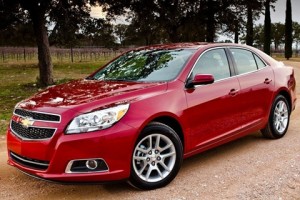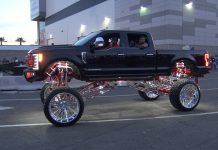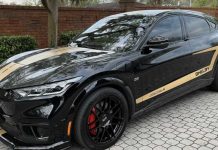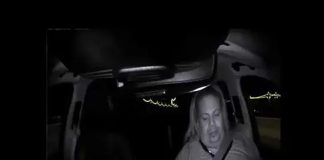The new Chevy Malibu was one of the earliest 2013 models to become available during early 2012 (I drove one back in April). It’s new in another way, too: It’s no longer available with a V-6 upgrade – but does offer an automatic engine stop-start function, just like a hybrid. There is also a battery to run the accessories when the engine’s not running. And a small electric motor, too – to boost the output of the 2.4 liter engine. 
It’s a hybrid in all but name (Chevy calls it “Eco”).
And it’s something you’ll be seeing a lot more of, as the car companies scramble to make their cars compliant with the nearly-here 35.5 MPG average fuel economy requirement that goes into effect three short calendar years (and so, two model years) from now, in 2016.
Thanks to its hybrid-esque equipment, the Malibu Eco is fuel-efficient. Or rather, much more fuel-efficient than the previous 3.6 liter V-6 powered Malibu (17 city, 26 highway) and almost fuel efficient enough to satisfy our ever-demanding Uncle: 25 city, 37 highway, so around 31 MPG average. That’s just 4 MPG below the 2016 par – and Chevy’s got three years to make up the difference.
The downside is the roughly $3,000 price premium Chevy wants for the Malibu Eco vs. a Malibu LS without the hybrid-esque equipment: $25,335 vs $22,390.
But, this sort of thing – especially the auto-stop thing – is going to be the new normal soon, thanks to Uncle.
Better get used to it.
The Malibu is Chevy’s mid-sized “bread and butter” family sedan. The Eco version that’s the subject of this review straddles the line between conventional (gas engine-only) cars and hybrid cars capable of operating on either gas or electricity (or a mix of both).
The Eco Malibu isn’t capable of moving down the road on electricity – but the gas engine does shut itself off automatically when the car is not moving. And a small electric motor provides supplemental power during acceleration.
Base price is $25,335 – for which you get 25 city, 37 highway – which is slightly better than the standard (gas engine-only) versions of competitors such as the Hyundai Sonata (24 city, 35 highway). But not quite as good as the hybrid versions of cars like the Sonata (35 city, 40 highway).
If the Malibu’s MPGs seem a little tepid relative to the competition, bear in mind that the real “competition” is Washington. Chevy’s goal – Chevy’s eed – is to placate the barons in DC as much as would-be customers.
For now, you can also buy a Malibu without the Eco equipment – and for less coin: $22,390 to start. Chevy also has a performance-minded version coming this fall which will be equipped with a turbocharged 2.0 liter engine.
WHAT’S NEW for 2013
The ’13 Malibu is all-new.
WHAT’S GOOD
Eco package’s auto-stop feature and electric-assist is unobtrusive and fuel efficient: Compact car MPGs in a mid-sized package.
Handsome-looking car, inside and out. 
Comfortable, wide-bottomed seats.
WHAT’S NOT SO GOOD
Malibu Eco’s MPGs are only slightly better than non-hybrid (and much less expensive) versions of the Hyundai Sonata/Kia Optima, Ford Fusion and Toyota Camry.
Comparably priced Camry hybrid offers much better city mileage (43 MPG).
Down-the-road repair/replacement costs for such things as the Eco starter motor could be exorbitant (more on this below).
UNDER THE HOOD
The Eco Malibu is equipped with a 2.4 liter engine that features direct injection and variable valve timing. It is paired with a small electric motor and 15 kW lithium-ion battery pack for extra boost during acceleration and also to provide power for accessories when the car is stationary – and the gas engine turns itself off. 
Total combined power output is 182 hp.
A six-speed automatic transmission with manual shift control function is the standard (and only) transmission offered.
The combo is good for an 8.7 second 0-60 run and 25 MPG city, 37 MPG on the highway.
These are pretty solid numbers – except for one thing: Competitors’ numbers are even better.
For instance, the non-hybrid (and only $20,995 to start) 2013 Hyundai Sonata has 198 hp and still manages a very respectable 24 MPG city, 35 MPG highway – a virtual dead heat with the $4,300 pricer-to-start 2013 Malibu Eco. The Sonata’s sportier-looking (but functionally identical) Kia cousin, the $21,200-to-start Optima, likewise delivers the same nearly-hybrid fuel economy without the Malibu Eco’s much higher sticker price.
There is also the hybrid version of the Sonata to consider. Its MSRP of $25,850 is about the same as the Malibu Eco’s price – but the Hyundai hybrid delivers significantly higher MPGs: 34 in city driving, 40 on the highway. Note that the Hyundai hybrid’s city mileage is 9 MPG better than the Malibu Eco’s.
The hybrid Toyota Camry ($25,990) does even better: 43 city, 39 highway. That’s nearly 20 MPG better in the city – a tremendous difference – for about the same price. And as with the Hyundai, the non-hybrid version of the Camry nearly matches the MPG performance of the more costly Malibu Eco: 25 city, 35 highway for $22,055 vs. $25,235 for the Chevy.
There’s also the Ford Fusion to consider. The hybrid version does cost about $2k more ($28,775) than the Malibu, but its fuel economy is excellent: 41 city, 36 highway. And once again, the regular (non-hybrid) Fusion does almost as well as the Malibu hybrid: 22 city, 32 highway – and does it for only $21,700.
You might also want to look at the $26,225 VW Passat diesel. It gets 31 city, 43 highway.
The Malibu Eco’s drivetrain functions conventionally – that is, like a normal, non-hybrid car’s – with the exception of the auto-stop function that Chevy went with as a way to improve the car’s MPGs. Other car companies are going the same route to CAFE compliance – BMW, for example – but Chevy’s system operates with superior finesse. It is literally unnoticeable – even when you floor the accelerator pedal from a dead stop – with the gas engine “dead” (not yet running). It turns on instantaneously, without any signs – or sounds – whatsoever of cranking. (In the new BMWs, you will notice by feel and sound the engine cutting off – and coming back on.) The car sprints forward normally.
It also helps the finesse that the Malibu has a conventional six-speed automatic rather than a continuously variable (CVT) “one speed” automatic. There’s less engine/drivetrain noise when accelerating – although not using a CVT probably cost Chevy a couple of MPGs that the Malibu Eco really could use. The fuel economy benefit is why you’re seeing more and more CVTs in service – including in hybrids such as the Ford Fusion hybrid. (The Hyundai Sonata, on the other hand, uses a conventional automatic and still gets extremely good mileage; with a CVT, it’d probably do even better.)
Acceleration is neither weak nor strong – it’s very middle of the road. For what it is – and what most buyers probably expect – it is certainly sufficient. Like almost any new car, once you’re in top gear, you can trundle along at nearly 80 MPH with the engine barely running 2,000 RPM.
The irony of our era is how effortlessly fast (and fairly fuel efficient when running fast) even “family” type cars like the Malibu are – and how illegal it is to make much use of their capabilities. Given the realities of the American road – of American traffic and American traffic laws – a bit less can’t-really-do-much-with-it capability in exchange for better everyday mileage would probably be a good swap. For example, 50 MPGs – and 10 seconds to 60, with a 100 or so MPH top speed capability – vs. 37 MPG, 8 seconds to 60 and a 130-plus top end.
Handling is a high point – not because the Malibu Eco corners like a BMW, but because the Malibu Eco doesn’t corner like most full-on hybrids. It feels completely… normal. Not heavy as many hybrids do. Which is remarkable, because the Malibu Eco is heavy: 3,589 lbs. (vs. 3,457 lbs. for the Hyundai Sonata hybrid).
Chevy has very effectively damped the Malibu’s suspension so that the extra weight doesn’t show itself like a beer belly in a T-shirt two sizes too small. The Eco even feels eager at a clip just above the legal – and it’s only when you’re well into the not-legal that it begins to get ruffled. But not unsettled. Just the normal body lean and decreasing grip threshold you’d expect to encounter in a family-type car being pushed harder than it was meant to be pushed. That’s all. The Malibu Eco hybrid feels more steady and confident than a non-hybrid Camry (arguably, the best ’96 Buick Regal Japan ever made) and a helluva lot more so than a hybrid Camry. It also handles with greater agility/confidence than the Sonata hybrid.
Driving-wise, it’s one of the best (if not the best) car in its class.
If it only it got better gas mileage.
Or cost less.
Chevy has been clumsy in the past as far as incorporating styling elements of its popular models into bread-and-butter models. A recent example of this being the over-large, retro-round taillights grafted onto the tail end of recent-vintage Impalas to try to conjure up fond memories of the old RWD (and V-8) muscle car Impalas of the ’60s. It didn’t work because there was nothing in common between the two cars except the name.
This is different. Chevy stylists took cues from the current Camaro and did a fine job blending them into the lines of the Malibu; you’ll see the DNA manifesting in the shape of gauge cluster and tail-lights, the semi-fastback rear glass, the overall hunky squat of the car. It’s integrated – not a grafted-on afterthought.
And it looks good. More than that, it looks – to my eye – just right for a family car. Not too boring – not over-sporty. It will wear well – and still look good five or six years from now.
The cabin of the Eco I tested was everything the PR sheet said it would be – “premium,” in car-biz lingo. Individually fitted panels (including the “toupee” over the gauge pod) covered in convincingly soft-touch leatherette material, with equally believable stitching buttoning it all up. The chrome bits had a deep, almost liquid look and the wood inserts weren’t obviously plastic. That plus features and equipment the previous Malibu lacked – such as GPS and music streaming via the Internet – amounts to a Great Leap Forward over the previous Malibu, which was a competent enough car but far from “premium.”
One deficit relative to some of the competition is interior space. The Malibu’s got 39 inches of front seat headroom and 42.1 inches of front seat legroom. This is not cramped – it’s actually about the same as you’d get in the Ford Fusion (38.7 inches and 42.3 inches, respectively) and a bit more than you’d get in a Camry (38.8 inches and 41.6 inches).
But it’s noticeably less spacious than the Hyundai Sonata’s almost full-sized car accommodations: 40 inches of headroom and 45.5 inches of front seat legroom – that’s 3.4 inches more than in the Chevy.
The Malibu does make up for this in the second row, which has 36.9 inches of legroom vs. the Hyundai’s 34.6 inches (headroom in the second row is a dead heat between the two; 37.6 for the Malibu and 37.8 for the Hyundai).
Trunk space is 14.3 cubic feet – decent – but slightly less than the Sonata’s 16.4 cubic foot trunk, the Camry’s 15.4 cubic foot trunk and the Fusion’s 16.5 cubic foot trunk.
There’s nothing objectionable about this car – other than the slightly awkward-to-use controller for changing gears manually, which is mounted on top of the shifter. To go up or down you have to move your thumb forward and back, pushing down to engage the + or the -. It’s not very ergonomic. I’m also not a huge fan of the electrically-actuated parking brake my test car came equipped with. Sure, it’s a neat gadget and it does free up space on the console that might otherwise be taken up by a manual pull-up parking brake.
But, two things: That electric actuator will probably cost a small fortune to fix when it fails. And eventually, it will fail. I’d rather have a simple, functional, manual-control cable. Also, note my use of the term, parking brake. What you don’t have is an emergency brake. If a car has a pull-lever brake on the console, and there’s a failure of the main braking system, you can use the emergency brake to slow the car down in a controlled manner. This is not possible with the electric parking brake, which cannot be modulated. It’s either on – or off. Even if the system let you engage the parking brake while the car is moving (which it probably won’t) the result be immediate wheel-lock and an uncontrolled skid. Not good.
So, give me the manual pull-up emergency brake every time.
The other electronic-related issue is the auto-stop function. To make this work, the car needs a specialized starter – a high-torque (and probably, high dollar) unit. Since it works much harder – and much more often – it is likely that it will fail sooner. And when it does, the cost to replace it might make you faint. I have heard – though not confirmed – that these specialize starters can cost upwards of $1,500 to replace. A conventional starter costs about one-fourth of that – and will usually outlast the car.
I am not looking forward to these doo-dads becoming commonplace. But thanks to Uncle, they will be.
THE BOTTOM LINE
I like this car – it’s a good car – I’m just hesitant to recommend this car given what you can get, MPG-wise and otherwise, at a Hyundai, Kia or Toyota dealer for about the same or less money. Chevy needs to figure out a way to get either the city or the highway MPGs into the 40s – or the price down by about $3k – in order for the Eco to be competitive with what’s on the market right now.
Meanwhile, I’m looking forward to trying out the Malibu without the Eco equipment – and with the turbo 2.0 liter engine.
Stay tuned… .
Throw it in the Woods?














Eric, what about Towing capacity on a 2500? I bet someone hauling a horse trailer, flatbed or RV will appreciate the “grossly” overpowered V-8.
I run cars and trucks to their useful limit. In late 2008 when trucks were ultra cheap I replaced my 18 year old F-150 with a chebby 2500 regular cab. It is a nice piece of work excepting the grossly overpowered V8.
I carry steel molds round trip to a chromium plater. It has twice the HP needed and the fuel consumption is gratuitously high. What I want does not fit the macho-man ads on NFL football TV.
Nevertheless, I use so little fuel on the short hops that the oversized engine is not a killer for me.
What about those that want to buy an economical truck? In 2008 there was no such thing.
I did get it for 6000 less than the going rate of the previous year. Six grand will buy a lot of gasoline that will reduce the sting of fuel prices.
If the goo would have left us alone I would have bought a far more economical city truck than what I now have.
There is nothing anywhere that will have a pickup with regular cab that will carry one ton in city conditions. Am I the only one that needs that specification? In the old days there were pickups that fit that need.
I run cars and trucks to their useful limit. In late 2008 when trucks were ultra cheap I replaced my 18 year old F-150 with a chebby 2500 regular cab. It is a nice piece of work excepting the grossly overpowered V8.
I carry steel molds round trip to a chromium plater. It has twice the HP needed and the fuel consumption is gratuitously high. What I want does not fit the macho-man ads on NFL football TV.
Nevertheless, I use so little fuel on the short hops that the oversized engine is not a killer for me.
What about those that want to buy an economical truck? In 2008 there was no such thing.
I did get it for 6000 less than the going rate of the previous year. Six grand will buy a lot of gasoline that will reduce the sting of fuel prices.
If the goo would have left us alone I would have bought a far more economical city truck than wahat I now have.
deleted
Still remember getting passed(not surprisingly) by diesel Super Dutys pulling riding mowers on little trailers while I’m pulling a fullsize pickup on a trailer behind my 90hp slant six Dodge with 30 car batteries in the back. Without all the extra weight (at least 6000lbs-probably more) it would go plenty faster than was legal. Instead of 300hp engines that (theoretically) get 20 mpg, how about 150 hp engines that get 40 mpg. And a big pickup pulling a trailer and grossing 20000lbs getting 10 mpg is equal to a 5000lb car getting 40mpg. Or a 2500lb car getting 80. A prius can’t match that.
At the end the article you hint at the monstrous maintenance costs waiting in the wings for the parking brake actuator, high-end starter, and I’m guessing many more similarly expensive elements hiding in the drivetrain and elsewhere. The extra fuel economy here appears to be cancelled by increases in maintenance costs.
Not liking the auto stop feature. Can it be disabled by the owner?
Hi Jeff,
Unfortunately, no…
See today’s follow-up (new lead article).
” a bit less can’t-really-do-much-with-it capability in exchange for better everyday mileage would probably be a good swap. For example, 50 MPGs – and 10 seconds to 60, with a 100 or so MPH top speed capability – vs. 37 MPG, 8 seconds to 60 and a 130-plus top end.”
Harumph!
I want Speed and Mileage!
Oh Yeah – that is why I prefer a motorsickle.
All in all – this article provides a pretty good reason to buy a Hyundai and not a Chevy Eco, although I am not sure that was your intent.
I try my best to provide an honest (and hopefully, informed) evaluation of a given car – and let you, the reader, come to the appropriate conclusion!
Me too.
Just trying to make a point, is all.
So many people plodding along at just barely the speeeeeeed limit (or less) in cars with the capability to easily and safely run 50 percent (or more) faster.
It’s silly, pointless – and depressing.
The 1930s. That’s where most of the problems are from I think. That’s where government really got going. Most things government freeze at the time government takes them over. So much of what government does in the USA is frozen in the 1930s.
Most driving method and regulation is apparently derived from driving a 1920 to 1935 domestically made bread and butter sedan in traffic one would find in rural Nebraska. At least that is my theory. Everything we are taught in driver’s ed, the backwards clover-law, the backwards courtesy, it all works well in rural Nebraska cicra 1932. It doesn’t scale and applying it to 21 century Chicago or anywhere but some rural area in early 1930s creates problems.
The irony of our era is how effortlessly fast (and fairly fuel efficient when running fast) even “family” type cars like the Malibu are – and how illegal it is to make much use of their capabilities. Given the realities of the American road – of American traffic and American traffic laws.
So, if you buy one of these things, you are supporting American Driving Conditions and Traffic Laws – not to mention a shitty Government (partially owned) company.
Even a Prius – or a Smart! – has more power/performance than is usable on most American roads! Or rather, by most American “drivers.”
I find myself passing crops of Clovers even when I am out driving my 14-year-old, 140,000 mile four-cylinder pick-up truck! Some of these Clovers are “driving” cars with two or even three times the hp of my truck – and far, far higher cornering capability.
Much as I love the fact that the typical new car is so capable, I can’t help being disgusted by the fact that to a great extent, most of this capacity is for looks-only.